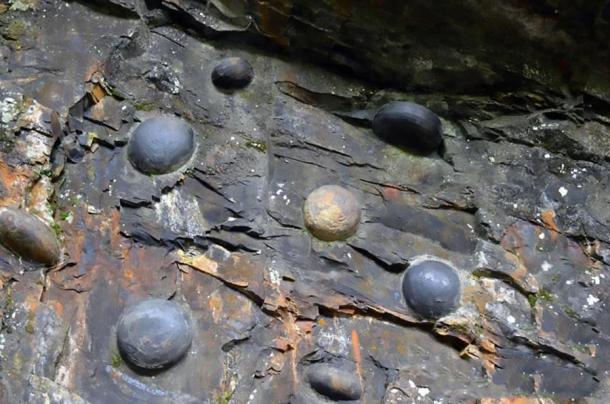Mount Gandang, a mountain in the southwest region of China, has an interesting phenomenon that geologists, researchers, and locals have been observing for decades. Located in the province of Guizhou, the rocky walls of the base of the mountain include a cliff that locals refer to as “Chan Dan Ya,” Mandarin for “egg-laying cliff,” due to its ability to “lay” stone “eggs” every 30 years. But, where are they coming from?
The egg-laying mountain cliff is approximately six meters (20 ft) wide and 20 meters (65 ft) long, which is fairly small in comparison to the size of the entire mountain. About every 30 years, the small cliff “lays” a stone egg from its side. Once the stone egg is released from the cliff, it falls to the ground where it can be found by the first local who is lucky enough to stumble upon it.
This stone egg-laying phenomenon has been observed for hundreds of years. Locals in that region have heard tales of the egg-laying mountain since childhood, and most go to visit it and try to find a dropped stone egg once they are grown enough to do so. Of the stone eggs that have been retrieved, they range in size between 20 to 60 cm (7 to 24 in) each. They have a dark blue hue and are almost perfectly smooth, making them able to reflect the sunlight at certain angles once cleaned and polished. The largest of the stones have even been found to weigh over 600 pounds (272 kg)!

Local resident with one of the stone eggs from the egg-laying mountain in China. (AsiaWire)
Rocks of Good Fortune Born of the Egg-Laying Mountain
The closest village to Chan Dan Ya is Gulu Village, an old region in Sandu Shui Autonomous County home to 250,000 Shui, which is over 60% of China’s Shui population. The Shui people are one of China’s 56 officially recognized ethnic groups, and they’ve been living in this region since before the Han Dynasty. Though the region itself is large, the Gulu village is actually quite small, having only a few dozen families calling it home.
The Shui name can be translated into the word “water,” a fitting representation considering their history of living by the waterside. Whether rivers or streams, the Shui people could be found living alongside them. At some point in history, several Shui communities were made to migrate to the mountains, where they currently remain while still retaining their love for the water. Their traditions, folklore, and other beliefs all revolve around the concept of water. Most of their clothing is dyed in shades of blue to match the color of the water. In fact, the Shui language was also developed with water in mind, as their language has ten different words meaning “fish.”
Since the discovery of their local egg-laying mountain, locals have reported over 100 eggs being found at the base of the cliff. Currently, about 70 reside in the village and are shared amongst the families based on who found them first. The rest, they say, have either been sold or stolen. The Shui people believe that the stone eggs, born of the egg-laying mountain, bring luck and good fortune, and they even worship the stones at times. They can be found in nearly all houses in the village and are highly respected by those who collect them, as they are thought to bring prosperity and safety to their people, animals, and homes.

Geologists still don’t completely understand why these stone eggs appear from the Chan Dan Ya cliff in China. (AsiaWire)
The Formation of Stone Eggs at Egg-Laying Mountain
The formation of these mysterious stone eggs is still being researched. Based on current research, it is believed that these eggs and the surrounding rock in this region were formed during the Cambrian Period some 500 million years ago. The Cambrian Period was part of the Paleozoic Era and is known for the “Cambrian Explosion” – the period of time in which most of the Earth’s major animal groups emerged and diversified, according to the fossil record. Geologists theorize that this region was once underwater, which may have contributed to the formation of these egg shaped rocks over time.
It is believed that due to the heat and compression on these stone eggs over these past 500 million years that they are now considered metamorphic rocks. Metamorphic rocks are formed from existing igneous or sedimentary rocks that are put under intense heat and pressure underground for an extended period of time.
Professor Xu Ronghua, from the Institute of Geology and Geophysics at the Chinese Academy of Science claims that the stone eggs are made of silicon dioxide, which would have been highly present in that region during the Cambrian Period. If this is true, he claims the stones being egg-shaped makes sense – because a sphere has a small surface area compared to other shapes, silicon dioxide particles would have clung together in a sphere shape in the water before being compressed into metamorphic rocks.
Being underwater itself would have also contributed to the roundness and smoothness of the stones. As rocks are tumbled along the ocean floor due to surrounding currents and animals, they wear away into smoother, rounder shapes. This same concept applies to the making of ocean glass or at-home rock tumblers.
Silicon dioxide is present in many rocks, with some rocks having a higher quantity of it than others. Fibrous silicon dioxide varieties are specifically called chalcedony. Examples of chalcedony include agate, bloodstone, and onyx. Quartz and moganite are also made of silicon dioxide, but each has a different physical crystal structure than each of these other examples. It is not entirely clear why the stone eggs are black rather than clear, milky, or pastel like other silicon stones, but scientists are actively trying to uncover further secrets of the composition of these mysterious stone eggs.
The surrounding area of the cliff outside of the eggs, however, is different. The cliff itself is not made of metamorphic rock. Instead, the surrounding rock is made of calcareous rock, which is considered sedimentary rock. Sedimentary rock can be found closer to the earth’s surface, and are made of compressed sediments such as sand, soil, or existing smaller rock pieces. Examples of sedimentary rocks include limestone, sandstone, and shale. With these sediments surrounding the stone eggs, it is possible they helped compress and separate them over the last 500 million years.

Stone eggs emerging from the Chan Dan Ya cliff. (AsiaWire)
Where Are They Coming From?
Though it may appear that the stone eggs are being formed over the course of 30 years and being “birthed” by the cliffside, this is actually not the case. As previously stated, it is believed these stone eggs have existed for nearly 500 million years. Over time, the cliffside of the Chan Dan Ya has worn down due to weathering and erosion. Changes in temperature and exposure to wind, water, ice, gravity, people, and animals can wear away at even the largest of rocks over time – including mountains.
Because the composition of the stone eggs and the surrounding cliff are different from one another, it is believed that the surrounding cliff is simply wearing away faster than the stone eggs themselves. This is because calcareous rock breaks down faster than metamorphic rock. Calcareous rock is primarily made of calcium oxide, carbon dioxide, and magnesium oxide.
They can also contain trace amounts of aluminum, iron, silicon, and water. The surrounding sedimentary calcareous rock breaks down faster due to its composition, revealing the stone eggs of a different composition over time. Because the metamorphic stone eggs aren’t breaking down with the surrounding cliff, they are falling out of the side as it wears away.
The locals in Gulu have estimated that it takes approximately 30 years for each stone egg to be “laid” by the mountain from its first appearance in the cliff to it falling to the ground. A stone egg that is just appearing may still have 30 years to go before the cliff erodes enough for it to fall, but a stone egg that is already partway out may only have 10 to 20 years to go. With all of the stone eggs being at different positions in the cliff, an egg could theoretically fall at any point for the next lucky person who finds one.
As the mountain continues to erode, stone eggs could start to emerge from pathways that are frequently traveled by the local Shui people and other tourists to the region. If this occurs, travel via footpath or horseback may prove more difficult and measures may have to be taken to physically remove or wear down the protruding eggs.

Stone eggs emerging from the egg-laying mountain in China. (AsiaWire)
The Future of the Egg-Laying Mountain
What is to come for the famous egg-laying mountain? As the mountainsides continue to wear away over time, more stone eggs will emerge from the cliff and fall to the ground. In addition, eggs may also begin to protrude at the tops of the mountain as it erodes from foot traffic, as previously mentioned. Geologists aren’t certain just how many eggs remain in the mountain, but theoretically, they could be throughout the entire mountain if the region contained enough silicon dioxide during the Cambrian Period. Ultimately nobody will know until the mountain runs out of stone eggs – if it ever does.
Over the next several thousand years, the mountain will continue to erode into the soil, leaving these eggs behind. If the eggs are no longer collected, they will remain on the ground where they, too, will break down and become sediment that will eventually build new sedimentary rocks. Such is the rock cycle we all learned about in grade school. Without being exposed to weathering factors such as soil, wind, water, and ice, however, the stone eggs could be preserved for much longer by humans if careful collection continues.
Other Egg-Laying Spots
Believe it or not, this particular cliff at the base of Chan Dan Ya is not the only area that is “laying eggs.” Other less-visited areas of the mountain also have eggs being exposed and released, further suggesting that the entire mountain is full of them. If this is true, locals could be seeing more of these unique rocks for many generations.
Families in other nearby areas may also begin collecting these eggs as more appear and use them for trade, tourism, or religious purposes. Those living on the other sides of the mountain that have previously never witnessed this egg-laying phenomenon may begin to see it themselves.
Though Mount Gandang has been the first location identified as having these stone eggs, it is possible that other locations could exist in unexplored mountainous regions. It is also possible that future mountains may contain more stone eggs. Currently, our oceans contain 30 ppb (parts per billion) of silicon dioxide, and the earth’s crust is made of 59% silicon dioxide.
With such large amounts of silicon still present both in the earth and in the oceans, it is possible that future mountains could contain newly made eggs several million years from now. Though we personally won’t be around to see these egg-laying mountains laying their eggs, perhaps those who will see it will be just as fascinated by it as we are.





